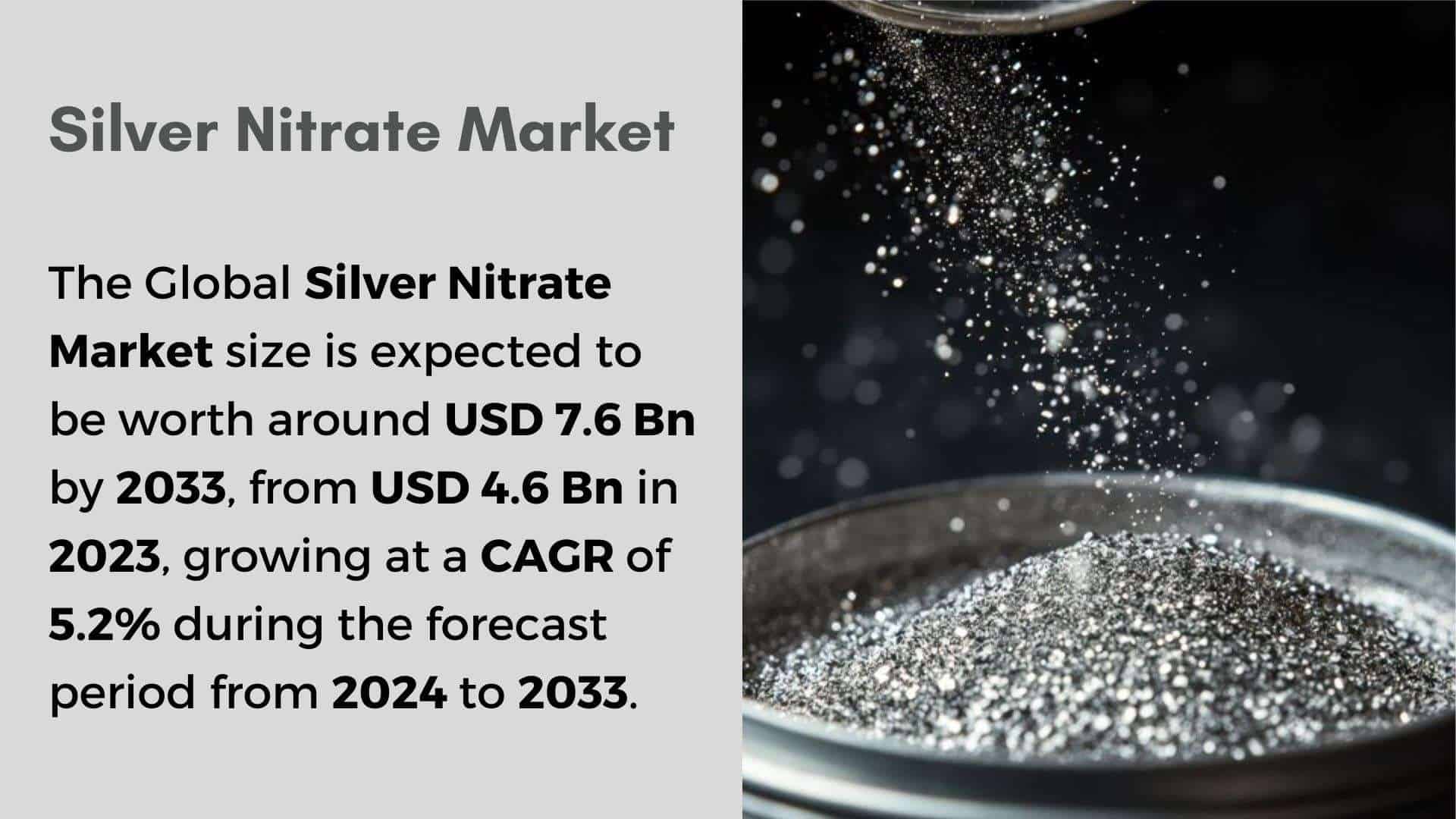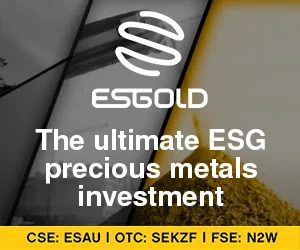Introduction
The Silver Nitrate Market is poised for significant growth in the coming decade, with projections indicating an increase from USD 4.6 billion in 2023 to around USD 7.6 billion by 2033. This represents a steady compound annual growth rate (CAGR) of 5.2%. The growth trajectory of this market is driven by the expanding applications of silver nitrate across various industries, including pharmaceuticals, photography, and water purification.
Market demand is particularly strong due to silver nitrate’s effectiveness as an antimicrobial agent, which is increasingly important in medical applications and healthcare products. Additionally, opportunities are emerging from technological innovations and the development of new formulations that enhance performance and safety.
The market’s expansion is also fueled by rising awareness of waterborne diseases and the subsequent need for effective water treatment solutions, where silver nitrate plays a crucial role. Overall, the market’s popularity continues to grow, driven by its broad utility and the continuous exploration of new market segments and geographic regions, presenting ample opportunities for market players.
Continuing this trajectory, the silver nitrate market is further buoyed by its indispensable role in the electronics industry, where it’s used in the production of conductive coatings and other critical components. This is particularly relevant as the demand for electronic devices, including smartphones and tablets, continues to soar globally.
Additionally, silver nitrate’s application in mirror production — crucial for both automotive and architectural industries — supports its market expansion. The versatility of silver nitrate also extends to the photographic sector; although traditional usage has declined, the chemical still finds new uses in high-quality printing processes and photographic restoration, ensuring sustained interest and investment in its production.
Market opportunities are not only being driven by industrial and technological applications but also by geographical expansion into emerging markets where industrial development is accelerating. These regions present new customer bases and increased demand for products that incorporate silver nitrate.
Furthermore, as regulations on the use of hazardous chemicals tighten, silver nitrate is increasingly viewed as a preferable alternative due to its lower environmental impact compared to other compounds with similar uses. This shift is likely to support continued market popularity and help maintain a steady growth rate in the face of evolving global regulatory and environmental landscapes. With these factors in mind, the silver nitrate market is set to continue its growth trajectory, supported by robust demand, widening applications, and strategic market expansions.
Key Takeaways
The Silver Nitrate Market size is expected to be worth around USD 7.6 billion by 2033, from USD 4.6 billion in 2023, growing at a CAGR of 5.2%.
Analytical Reagent Grade held a dominant market position, capturing more than 38.2% of the global Silver Nitrate Market.
99.5% purity grade held a dominant market position, capturing more than 46.4% of the global Silver Nitrate Market.
Solid form held a dominant market position, capturing more than 59.2% of the global Silver Nitrate Market.
Photography & Jewelry held a dominant market position, capturing more than 29.3% of the global Silver Nitrate Market.
Medical & Pharmaceutical held a dominant market position, capturing more than 37.2% of the global Silver Nitrate Market.
Direct Sales held a dominant market position, capturing more than 65.2% of the global Silver Nitrate Market.
North America dominated the global Silver Nitrate market in 2023, holding a market share of 35.4%, valued at USD 1.6 billion.
Silver Nitrate Statistics
Applications and Properties of Silver Nitrate
Silver nitrate is a versatile compound with a molar mass of 169.872 grams per mole. In its solid state, it has a density of 4.35 grams per cubic centimeter, while its liquid state density at 210°C is 3.97 g/cm³. The melting and boiling points of silver nitrate are 482.8 K and 713 K, respectively.
Silver nitrate dissolves readily in water, with solubility corresponding to 122g/100mL at 0°C and 256g/100mL at 25°C. When heated to 440°C, it decomposes to yield oxygen, nitrogen dioxide, and silver.
Silver Nitrate Production and Market Trends
Silver nitrate solutions with nitric acid are produced under specific conditions, including a stirring speed of 500 rpm and a crystallization period of 240 minutes, yielding the highest output. Currently, about 80% of domestic silver nitrate is utilized to manufacture silver powder, primarily supplied to the photovoltaic industry. The remaining 20% is used for reagent-grade silver nitrate, catalysts, silver plating raw materials, and other applications.
In 2023, the domestic market is estimated to be around 8,500 tons, with projections suggesting that silver nitrate production will reach between 9,500 and 10,000 tons. China’s annual import volume of silver nitrate ranges from 1 to 3 tons, while its export volume fluctuates between 3 and 9 tons.
Emerging Trends
Increased Use in Wound Care
There’s a notable advancement in wound care solutions involving silver nitrate, including the development of time-released dressings and hydrogel sheets containing silver nitrate. These innovations aim to enhance the effectiveness of wound care products by leveraging silver nitrate’s antimicrobial properties.
Digital Photography Applications
Despite the shift towards digital photography, silver nitrate remains crucial in producing black-and-white photographic films and papers, where it forms light-sensitive silver halide crystals essential for photosensitivity. Its use in niche areas like fine art photography and industrial X-ray films continues to sustain its demand.
Growth in Healthcare Expenditure
Rising healthcare expenditures, especially in emerging economies, are boosting the demand for silver nitrate in medical applications. The increase in disposable incomes and health consciousness is expected to drive the adoption of advanced medical products containing silver nitrate.
Technological Collaborations and M&A
The market is witnessing a trend of strategic partnerships and mergers & acquisitions among key players. These collaborations aim to develop innovative applications and expand production capacities of silver nitrate, thus fueling market growth.
Environmental and Regulatory Focus
There is a growing focus on environmental and safety regulations concerning the use of silver nitrate, given its toxic nature. Compliance with these regulations is pivotal for manufacturers, impacting market dynamics and possibly restraining growth due to stringent policies and the availability of safer alternatives.
Use Cases
Medical Treatments
Silver nitrate is highly valued in the medical field for its antimicrobial properties, often used in dressings to treat burns, ulcers, and skin diseases. It’s also employed in eye care, particularly for newborns, to prevent bacterial infections.
Analytical Chemistry
In chemistry, silver nitrate serves as a critical reagent for titration processes. It’s particularly effective in determining the concentration of halide ions in solutions, which is essential for environmental testing and laboratory analyses.
Photography
Though its role has diminished with the rise of digital technology, silver nitrate remains important in producing light-sensitive materials used in traditional black-and-white photography. It reacts with halide salts to create silver halides, crucial for developing photographic films.
Manufacture of Mirrors and Glass
Silver nitrate reacts to form a metallic silver layer on glass, producing mirrors and enhancing the reflective properties of optical devices. This application spans from household mirrors to sophisticated equipment in scientific research.
Electronics
In electronics, silver nitrate is utilized for its conductivity. It’s incorporated into processes like the production of conductive adhesives and pastes, essential for printed circuit boards (PCBs) and other electronic components.
Major Challenges
Toxicity and Health Concerns
Silver nitrate’s toxic properties pose significant health risks, including potential skin, eye, and respiratory issues upon exposure. The environmental impact of its runoff is also concerning, as it can harm aquatic life, prompting strict regulatory oversight on its use and disposal.
Regulatory Compliance
The stringent regulations governing the use of silver nitrate due to its toxicity lead to increased operational costs for manufacturers. Compliance with these regulations is necessary but can be costly and complex, impacting market growth.
Competition from Alternatives
Silver nitrate faces competition from other antimicrobial agents that are less expensive and have milder side-effect profiles. The availability of these alternatives can make it challenging for silver nitrate to maintain its market share, especially in medical and wound care applications.
Market Volatility
Economic fluctuations and varying industrial demands impact the silver nitrate market. Shifts in key sectors such as healthcare, electronics, and water treatment can lead to market instability, affecting production and pricing strategies.
Market Growth Opportunities
Medical and Pharmaceutical Applications
There’s significant growth potential in the medical and pharmaceutical sectors, where silver nitrate’s antimicrobial properties are highly valued. Its use in wound dressings and other medical devices continues to expand, driven by global health advancements and increasing healthcare expenditures.
Electronics Industry
The electronics sector presents a robust opportunity for silver nitrate, particularly in producing conductive adhesives and other components that rely on its high electrical conductivity. As technology advances, the demand in this area is expected to rise.
Water Treatment
Silver nitrate’s application in water treatment as a biocide to combat pathogens offers growth opportunities, particularly in regions facing water scarcity and requiring sustainable water purification solutions.
Photographic Materials and Jewelry
Despite the rise of digital technology, silver nitrate remains crucial in the niche markets of black-and-white photography and jewelry making, where it plays a key role in producing high-quality photographic films and crafting silver alloys.
Advancements in Nano and Biotechnology
Innovations in nano and biotechnologies provide new avenues for silver nitrate applications, especially in creating advanced materials with enhanced properties for medical and electronic applications.
Key Players Analysis
Several key players dominate the silver nitrate market, including:
Ames Goldsmith Corporation: Established in 1860, this company is a leading global manufacturer of silver nitrate, producing high-purity grades for various applications, including photography, electronics, and medical uses.
GFS Chemicals: Founded in 1928, GFS specializes in producing silver nitrate and other fine chemicals, serving industries such as pharmaceuticals, electronics, and research laboratories with high-quality reagents.
ProChem, Inc.: Established in 1986, ProChem manufactures silver nitrate and a wide range of chemical products, catering to sectors like academic research, pharmaceuticals, and industrial applications.
Merck KGaA: A prominent science and technology company, Merck supplies silver nitrate among its extensive portfolio of chemicals, supporting industries including healthcare and life sciences.
Thermo Fisher Scientific Inc.: A global leader in scientific services, Thermo Fisher provides silver nitrate for various applications, supporting sectors such as healthcare and research.
Spectrum Chemical Manufacturing Corporation: This company offers silver nitrate and a comprehensive range of laboratory chemicals, serving industries like pharmaceuticals and biotechnology.
American Elements: A manufacturer and supplier of silver nitrate and advanced materials, catering to industries such as electronics and medical devices.
Central Drug House Pvt. Ltd (CDH): Based in India, CDH produces silver nitrate and a variety of laboratory chemicals, focusing on quality and compliance with international standards.
ALPHA CHEMIKA: An Indian chemical manufacturer offering silver nitrate in its product line, emphasizing high-quality reagents and customer satisfaction.
East India Chemicals International: This company provides silver nitrate and other industrial chemicals, focusing on quality products and reliable supply chains.
S D Fine-Chem Limited (SDFCL): A manufacturer of silver nitrate and laboratory chemicals, serving sectors like pharmaceuticals and education.
Conclusion
The Silver Nitrate Market is positioned for substantial growth, driven by its diverse applications across medical, photographic, electronics, and water treatment industries. As a versatile chemical compound known for its antimicrobial and conductive properties, silver nitrate plays a critical role in various sectors, offering opportunities for innovation and expansion.
Challenges such as toxicity concerns and stringent regulations highlight the need for careful management and compliance. However, with ongoing advancements in technology and increasing global demand in key areas, the silver nitrate market is expected to continue its upward trajectory, presenting lucrative prospects for stakeholders to capitalize on its expanding utility.
Discuss Your Needs With Our Analyst
Please share your requirements with more details so our analyst can check if they can solve your problem(s).




